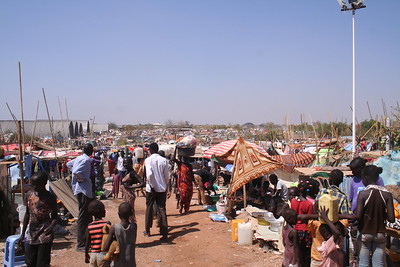At Least 40 Killed After Airstrike in Sudan
Hamzah Khan
Managing Editor
On September 10, an airstrike on an open marketplace in the Sudanese capital of Khartoum resulted in over 40 deaths and more than 55 wounded, reports The Associated Press. The attack was the latest carried out by the Sudanese army as Khartoum has become an open battleground between two rival military factions in the country since April 2023. Videos released by witnesses showed dozens of bodies being covered in white shrouds although it is unclear whether the victims were all civilians, according to Al Jazeera. Khartoum has borne the brunt of the fighting as much of its infrastructure, including famous buildings like the Greater Nile Petroleum Oil Company Tower, has been damaged, reports BBC.
Sudan has been embroiled in an open conflict between the country’s military, led by General Abdel Fattah al-Burhan, and a paramilitary group called the Rapid Support Forces (RSF), led by General Mohamed Hamdan Dagalo, since April 15, 2023. The two groups were initially allies as they orchestrated a coup against the civilian government in Sudan in October 2021, according to the Council on Foreign Relations. General Burhan became the de facto ruler of Sudan and Dagalo, also known as Hemedti, became his second-in-command, according to Al Jazeera. Both the RSF and military were accused of killing pro-democracy protestors who took to the streets after the coup.
The fighting has so far killed more than 4,000 people, although experts believe the death toll to be much higher. A further 7 million have been internally displaced and around 1 million have become refugees, reports The Associated Press. Beyond the fighting, lack of humanitarian aid has led to the deaths of nearly 1200 children in Sudan’s refugee camps, reports Reuters. Measles and cholera have also spiked in the country as the healthcare system nears collapse.
The New York Times describes the current conflict between Burhan and Dagalo as a power struggle between the two rival generals for control of Sudan after the coup. General Burhan rose through the ranks of the military during his 30-year career while Sudan was ruled by its longtime dictator, Omar al-Bashir. Bashir was later brought down by the military after overwhelming protests in the country against his rule back in 2019, Al Jazeera furthers. The subsequent transitional government consisted of civilian factions as well as military and paramilitary groups like the RSF. The army consists of nearly 300,000 soldiers and dominates much of the country due to its superior air and manpower, while the RSF has a strong grip in the southern region of Darfur as well as enclaves in Khartoum. Multiple ceasefires were agreed to and then immediately violated, while humanitarian aid has become increasingly difficult to access.
The Rapid Support Forces was created in 2013, evolving from the Janjaweed militias that carried out horrific atrocities on ethnic groups in Darfur in the mid-2000s. Former dictator Bashir and leaders of these militias were indicted by the International Criminal Court in 2009 over accusations of genocide, reports Amnesty International. Dagalo has led the RSF since its establishment and commands nearly 100,000 fighters. The RSF was legitimized under Sudanese law in 2017, which concerned many members of the military at the time, reports Reuters. Since then, they have functioned as a second military in the country, often working in tandem to put down pro-democracy protests.
The main point of contention between the two groups is the extent to which the RSF should be integrated into the army. Dagalo wants the RSF to maintain a level of independence, while the army wants to consolidate the country’s military forces. Both generals were also under pressure from the West as well as African and Arab states to transition to democracy, something they both wanted to avoid, according to The New York Times. Six months into the conflict, the civilian death toll continues to rise as diseases rip through the country and the refugee crisis worsens.
Image courtesy of Flickr


